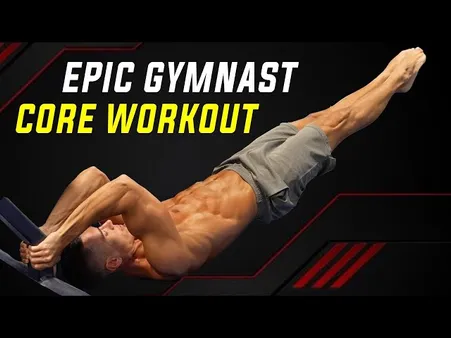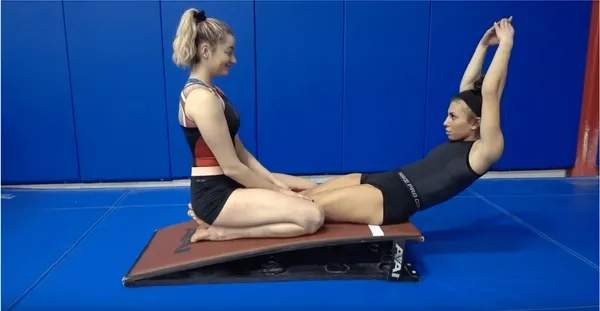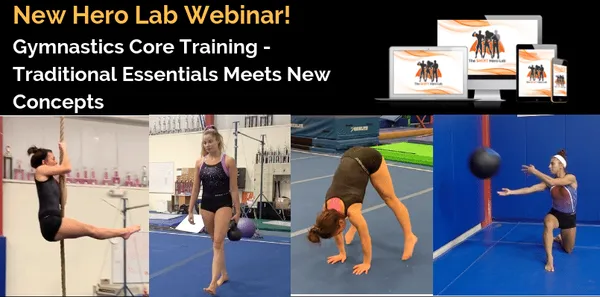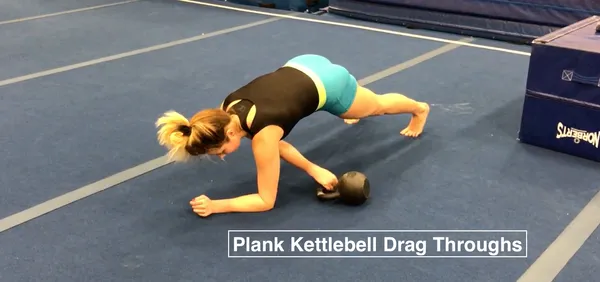Table of Contents
Gymnastics exercises are an excellent way to build core strength, improve balance and coordination, and enhance overall fitness. Whether you're a seasoned gymnast or just starting out, incorporating these exercises into your routine can provide numerous benefits. In this comprehensive guide, we'll explore The best gymnastics exercises for core strength, their benefits, types, and techniques. We'll also provide tips for beginners and discuss safety precautions to ensure you get the most out of your workouts. So, get ready to strengthen your core and unlock your gymnastic potential with Kizworld.
The Best Gymnastics Exercises for Core Strength: Build a Strong Core Like a Champ
I. Gymnastics Exercises: Core Strength
Gymnastics Exercises: Core Strength
Gymnastics exercises are an excellent way to build core strength, improve balance and coordination, and enhance overall fitness. Whether you're a seasoned gymnast or just starting out, incorporating these exercises into your routine can provide numerous benefits. In this comprehensive guide, we'll explore the best gymnastics exercises for core strength, their benefits, types, and techniques. We'll also provide tips for beginners and discuss safety precautions to ensure you get the most out of your workouts. Visit our post on How to do a Handstand for more insights into this impressive gymnastic move. So, get ready to strengthen your core and unlock your gymnastic potential with kizworld.
Types of Gymnastics Exercises for Core Strength
There are many different types of gymnastics exercises that can help you build core strength. Some of the most popular and effective exercises include:
- Plank:
- V-Up:
- L-Sit:
- Superman:
- Hollow Body Hold:
- Crunches:
- Leg Raises:
- Flutter Kicks:
- Bicycle Crunches:
- Side Plank:
For a comprehensive guide on the benefits of gymnastics for kids, check out our dedicated post on The Benefits of Gymnastics for Kids.
Each of these exercises targets different core muscles and can be modified to suit your fitness level. Discover the best gymnastics equipment for home use in our informative article on The Best Gymnastics Equipment for Home Use.
Benefits of Gymnastics Exercises for Core Strength
Incorporating gymnastics exercises into your routine can provide a number of benefits, including:
- Increased Core Strength:
- Improved Balance and Coordination:
- Enhanced Overall Fitness:
- Reduced Risk of Injury:
- Improved Posture:
- Better Athletic Performance:
Learn How to Improve Your Flexibility and Mobility With Gymnastics in our dedicated article. Gymnastics exercises can help you achieve your fitness goals, whether you're looking to improve your athletic performance, lose weight, or simply get in better shape. Read our comprehensive guide on The History and Evolution of Gymnastics for a deeper understanding of this captivating sport.
How to Perform Gymnastics Exercises for Core Strength
To perform gymnastics exercises for core strength, it's important to focus on proper form and technique. Here are some general tips:
- Start slowly and gradually increase the intensity and duration of your workouts.
- Focus on engaging your core muscles throughout each exercise.
- Keep your spine straight and avoid arching your back.
- Control your movements and avoid jerking or bouncing.
- Breathe deeply and avoid holding your breath.
Find the best Martial Arts Schools and Instructors near you with our comprehensive guide on How to Find the Best Martial Arts School and Instructor. Beginners should start with simple exercises, such as the plank and V-up, and gradually progress to more challenging exercises as they get stronger.
Exercise | Target Muscles | Benefits |
Plank | Abdominals, obliques, lower back | Strengthens core, improves balance and coordination |
V-Up | Abdominals, obliques, hip flexors | Strengthens core, improves flexibility |
L-Sit | Abdominals, obliques, shoulders | Strengthens core, improves balance and coordination |
Superman | Lower back, glutes, hamstrings | Strengthens lower back, improves posture |
Hollow Body Hold | Abdominals, obliques, lower back | Strengthens core, improves flexibility |
For more gymnastic skills and techniques, check out our ultimate guide on How to Master the Basic Gymnastics Skills. It's important to listen to your body and stop if you feel pain. Discover the top gymnastics competitions and events in our comprehensive article on The Top Gymnastics Competitions and Events.
Tips for Beginners
If you're new to gymnastics exercises, here are a few tips to help you get started:
- Start with simple exercises and gradually progress to more challenging ones.
- Focus on proper form and technique to avoid injury.
- Listen to your body and stop if you feel pain.
- Stay hydrated and eat a healthy diet to support your workouts.
- Find a gymnastics class or coach to help you learn the basics.
Meet the most famous gymnasts of all time in our tribute article on The Most Famous Gymnasts of All Time. With dedication and consistency, you can achieve your fitness goals and unlock your gymnastic potential.
Safety Precautions
To ensure your safety while performing gymnastics exercises, it's important to take the following precautions:
- Warm up before your workout and cool down afterwards.
- Use a mat or other soft surface to cushion your landings.
- Spot yourself or have a partner spot you when performing difficult exercises.
- Listen to your body and stop if you feel pain.
- Avoid overtraining and give your body time to recover.
Learn How to Train Like a Gymnast with our comprehensive training guide. By following these safety precautions, you can help prevent injuries and make the most of your workouts. Explore the best gymnastics apps and websites in our dedicated article on The Best Gymnastics Apps and Websites.
II. Gymnastics lingo: Planche and Beyond
Gymnastics lingo: Planche and Beyond
The planche is an advanced gymnastic move that requires immense upper-body strength and control. In this move, the gymnast holds their body in a horizontal position with their arms extended and their back straight. The planche can be performed on the floor, on parallel bars, or on rings. Some gymnasts can even hold a planche for several seconds, making it one of the most visually stunning and impressive moves in gymnastics.
- The planche is a static hold, meaning that the gymnast maintains the position for a period of time.
- The planche can be performed on the floor, on parallel bars, or on rings.
- The planche is an advanced move that requires a high level of strength and control.
Beyond the planche, there are a number of other advanced gymnastics moves that require exceptional strength and flexibility. These moves include the iron cross, the Maltese cross, and the human flag. These moves are often performed by elite gymnasts in competitive routines.
While gymnastics can be a challenging sport, it can also be very rewarding. Gymnasts who are able to master the advanced moves described above are often hailed as some of the best athletes in the world. Read more about finding the right gymnastics instructor.
Move | Description |
Planche | A horizontal hold with the arms extended and the back straight |
Iron Cross | A hold in which the gymnast's body forms a cross shape |
Maltese Cross | A hold in which the gymnast's body forms a Maltese cross shape |
Human Flag | A move in which the gymnast holds their body parallel to the ground with one hand |
These are just a few of the many advanced gymnastics moves that require exceptional strength and flexibility. These moves are often performed by elite gymnasts in competitive routines. Learn more about the difference between striking, grappling, and mixed martial arts.
III. Common Mistakes to Avoid
Common Mistakes to Avoid
While performing gymnastics exercises for core strength, it's important to avoid common mistakes that can hinder your progress or lead to injuries. Here are some mistakes to watch out for:
- Incorrect Form: Failing to maintain proper form during exercises can compromise your core engagement and increase the risk of injury. Ensure you execute each exercise with the correct technique and alignment.
- Overtraining: Pushing yourself too hard or engaging in excessive training can lead to burnout, fatigue, and potential injuries. Listen to your body and allow adequate rest and recovery time between workouts.
- Ignoring Warm-Up and Cool-Down: Neglecting a proper warm-up before and a cool-down after your workout can increase the risk of muscle strains and injuries. Dedicate a few minutes to warm up your muscles and gradually cool down to promote recovery.
- Neglecting Core Activation: Before performing core-specific exercises, it's crucial to activate your core muscles. Engage your core by pulling your belly button towards your spine and maintaining a neutral spine position throughout the exercises.
- Holding Your Breath: Holding your breath during exercises can restrict oxygen flow to your muscles, leading to fatigue and decreased performance. Remember to breathe naturally and smoothly throughout each exercise.
By avoiding these common mistakes, you can optimize your gymnastics exercises for core strength, minimize the risk of injuries, and achieve better results.
If you're new to gymnastics or looking to enhance your core strength, consider checking out our comprehensive guide on The Best Gymnastics Exercises for Core Strength. This guide provides detailed instructions, variations, and tips for various exercises to help you build a strong and stable core.
IV. Warm-up and Cool-down Exercises
Warm-up and Cool-down Exercises
Before starting any gymnastics workout, it's crucial to warm up your muscles to prevent injuries and improve performance. Dynamic stretches, such as leg swings, arm circles, and torso twists, are excellent for warming up. Additionally, light cardio exercises like jogging or jumping jacks can help elevate your heart rate and prepare your body for the workout. After your workout, cool down with static stretches to help your muscles recover and reduce soreness. Hold each stretch for at least 30 seconds, focusing on major muscle groups like your hamstrings, quadriceps, and shoulders.